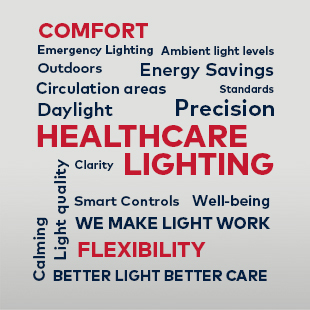10 questions to ask on every hospital lighting project
Healthcare settings present a wide range of lighting challenges. From the reception area to the recovery room, here are the key questions you’ll need to consider

1. What standards apply?
Before beginning a healthcare lighting project, be aware of the relevant standards. The European standard for indoor workplace lighting (EN12464-1) covers healthcare settings, and has recommendations for light levels, glare and colour rendering. The Society of Light and Lighting’s healthcare lighting guide provides further advice. Other standards and guidelines exist for specific topics, such as EN1838 for emergency lighting.
2. How can you make the most of natural light?
Daylight can work wonders. Access to natural light and the view from a window are known to be key factors in giving patients a sense of wellbeing and aiding recovery. Combined with smart controls, daylight is also a great opportunity to save energy.
3. What quality of light does each area need?
In areas where patients are being diagnosed and treated, light has to be the very best quality. A colour rendering index of 90+ is recommended, while for other areas 80+ will be enough. Glare and flicker are also important factors to consider, so that clinicians can do their best work and patients feel comfortable.
“People are not always sitting up straight or standing”
4. What angles will people see the lights from?
Imagine lying on a hospital bed facing the ceiling, being pushed along a corridor. This happens a lot in hospitals, and lights glaring in your face can make it an uncomfortable experience. In healthcare settings, people are not always going to be sitting up straight or standing, which means light sources can get into the field of view, causing glare which can disrupt clinical work and cause discomfort. Good lighting design needs to avoid this.
“If lights fail or require maintenance, important work may be disrupted”
5. How can disruption from maintenance be minimised?
If lights fail or require maintenance in a healthcare environment, important work may be disrupted. This can be avoided by choosing products that last a long time and are easy to maintain. Lighting controls can also help to extend the lifetime of products and make it easier to prevent and manage faults.
6. How can energy consumption be kept low?
Good quality LED light sources use surprisingly little electricity, keeping costs and carbon emissions down. And remember, daylight is free of charge. Lighting controls based on ambient light levels and room occupancy will help to get energy usage down even further.
“Different areas will have very different priorities”
7. What controls are required?
Well designed lighting controls can cut energy costs while also making spaces more flexible and suitable for specialised activities. Timers, light sensors and occupancy sensors can help make sure lights are only on when they’re needed. Luminaires can be controlled individually or as groups, and wireless control can make installation and operation easier.
8. How can light best support wellbeing?
As well as providing clarity and precision for clinical procedures, healthcare lighting should also help patients feel calm and comfortable. Different areas will have very different priorities. Where possible, use soft lighting that flatters appearance and doesn’t create glare. Warmer colour temperatures of around 3000k may be preferable in areas designed for rest and relaxation.
9. How can lighting help minimise risk of infection?
Dust, dirt or moisture collecting on light fittings can risk spreading infections. For healthcare environments, fittings should be easy to clean, with vertical or downward-facing surfaces that don’t collect dust, and with an appropriate ingress protection (IP) rating to avoid anything getting inside.
“The best emergency lighting goes far beyond the baseline legal requirements”
10. Will people be able to see their way out in an emergency?
Like all buildings, healthcare settings are required to provide emergency lighting, so people can make their way out of the building safely if there is a power failure. The system should meet the standard EN1838, and needs to be regularly tested and maintained. The best emergency lighting goes far beyond the baseline legal requirements, to offer easy testing and maintenance, and long lifetime.

